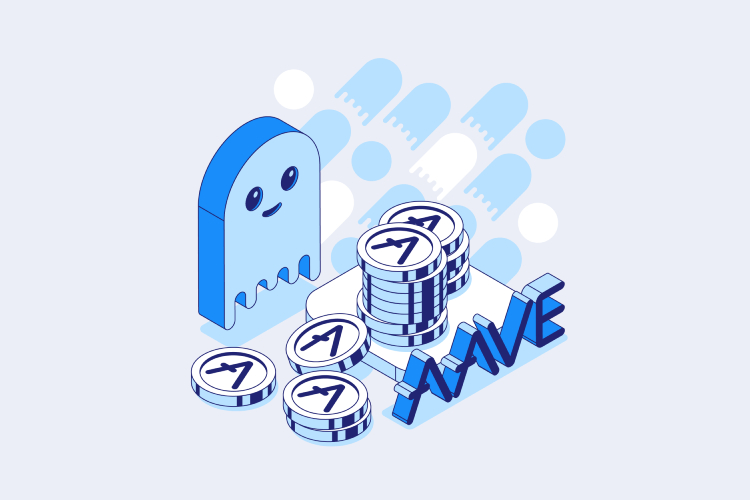Aave, in particular, has gained attention for its unique features, including flash loans, variable interest rates, and the ability to swap tokens directly within the platform. Its native AAVE token and stablecoin-backed aTokens also provide users with governance rights and incentives to participate on the platform.
Key Takeaways
- Aave is a decentralized exchange built on the Ethereum blockchain, founded in 2017 by Stani Kulechov
- It provides a platform for users to deposit their crypto assets as collateral and borrow other assets in return
- Its “pool-based” system allows for efficient use of capital and reduces the need for idle funds
- Aave has variable interest rates, flash loans, token swaps, gas optimization measures, and an AAVE token for governance rights
- Aave offers lower fees, faster transaction times, and increased accessibility than traditional finance and certain centralized exchanges
- Risks include potential market volatility, smart contract vulnerabilities, and hacking
- Aave taken steps to minimize risks such as insurance coverage, safety module, audits, and governance process
Introduction
Welcome to Coinmama Academy’s comprehensive guide to Aave. Is Aave just another decentralized exchange? Or is it the future of decentralized lending? In this article, we will explore what Aave is, how it works, and why it has become a popular decentralized exchange platform for investors and borrowers in the decentralized finance (DeFi) space.
In this guide, we will delve into the mechanics of Aave, discuss its benefits and risks, compare it with traditional finance, and explore its potential impact on the future of DeFi. So, let’s get started!

What is Aave?
Aave is a decentralized finance (DeFi) protocol built on the Ethereum blockchain. It was founded in 2017 by Stani Kulechov, a software engineer and entrepreneur, under the name ETHLend. In 2018, the project was rebranded as Aave, which means “ghost” in Finnish.
The purpose of Aave is to provide a decentralized lending and borrowing platform that enables users to transact without intermediaries. Aave allows users to deposit their cryptocurrency assets as collateral and borrow other assets in return. The collateral is managed by smart contracts on the Ethereum blockchain, ensuring transparency and security.
One of the unique features of Aave is its utilization of a “pool-based” system. Rather than matching lenders and borrowers directly, Aave pools user deposits into “liquidity pools,” from which borrowers can then draw funds. This allows for more efficient use of capital and reduces the need for idle funds.
Aave differs from other decentralized exchanges in that it allows for variable interest rates, which are determined by market supply and demand. This provides borrowers with more flexibility and can lead to lower interest rates. Aave also offers flash loans, which allow users to borrow assets without collateral for a very short period of time.
As a result of its unique features and functionality, Aave has gained significant popularity among investors and borrowers in the DeFi space. Its total value locked (TVL) has surpassed that of many other decentralized exchanges, making it one of the largest DeFi protocols in the market.
In the next section, we will delve deeper into how Aave works and the mechanics behind its lending and borrowing processes.
How does Aave work?
Aave operates on the Ethereum blockchain, utilizing smart contracts to enable decentralized lending and borrowing. Here’s how the process works:
Lending
Users can deposit their crypto assets into Aave’s liquidity pools, which are comprised of a variety of different assets. By depositing their assets, users become “lenders” on the platform and earn interest on their deposits. The interest rate is variable and determined by supply and demand for the asset.
Borrowing
Users can also borrow assets from the liquidity pools by providing collateral in the form of other cryptocurrency assets. The collateral is held in a smart contract on the Ethereum blockchain, ensuring transparency and security.
Once the collateral is deposited, users can borrow assets up to a certain percentage of the value of their collateral, which varies based on the type of asset. The borrowed assets can then be used for various purposes, such as trading or investing.
Interest Rates
Interest rates on Aave are determined by the supply and demand for each asset. If there is high demand for a particular asset, the interest rate will increase, incentivizing lenders to deposit more of that asset into the liquidity pool. On the other hand, if there is low demand, the interest rate will decrease, making it more attractive for borrowers to take out loans using that asset.
Flash Loans
Aave also offers flash loans, which allow users to borrow assets without collateral for a very short period of time, typically a few seconds. These loans are useful for arbitrage opportunities or other quick trades that require immediate access to funds. However, if the borrowed funds are not returned within the same transaction, the loan is automatically canceled.
Security
Smart contracts are used to store and manage all transactions on the Aave platform, ensuring transparency and security. The collateral provided by borrowers is held in these contracts and can be liquidated if the value of the collateral falls below a certain threshold, protecting lenders from losses.
Next up,Coinmama Academy will highlight some of the key features of Aave that set it apart from other decentralized exchanges.
Key Features of Aave
Aave offers several unique features that set it apart from other DeFi protocols. Here are some of the key features:
Flash Loans
One of Aave’s most notable features is its flash loans. As mentioned above, flash loans allow users to borrow assets without collateral for a very brief period to capitalize on arbitrage opportunities. These loans are typically used by very experienced traders and sophisticated investors.
Variable Interest Rates
Aave’s interest rates are variable and determined by supply and demand for each asset. This provides borrowers with more flexibility and can lead to lower interest rates. Lenders can also earn higher returns when there is high demand for an asset.
Token Swaps
Aave allows users to swap tokens directly within the platform, without the need for an external centralized or decentralized exchange. This saves users time and fees associated with transferring tokens to an external exchange.
Gas Optimization
Aave has implemented gas optimization measures to reduce the cost of transactions on the platform. These measures include batched transactions, which allow multiple transactions to be processed in a single block, and gas token refunds, which can reduce the cost of gas fees.
Governance
Aave’s native AAVE token gives users governance rights over the platform. This means that token holders can vote on proposals for the platform’s development and direction.
Safety Module
Aave has a safety module in place to protect against losses due to smart contract vulnerabilities or unexpected market events. The safety module is funded by AAVE tokens and can be used to compensate users in the event of a loss.
Aave’s unique features and functionality have contributed to its popularity and success in the DeFi space. Next, let’s explore the benefits of using Aave for investors and borrowers.
Aave Tokens
Aave has two main tokens associated with its platform: the native AAVE token and the stablecoin-backed aTokens. Here’s what you need to know about each:
AAVE Token
The AAVE token is the native token of the Aave platform. It serves several functions, including:
- Governance: AAVE token holders have voting rights on platform governance decisions, such as protocol upgrades or fee changes.
- Safety Module: AAVE tokens are used to fund the safety module, which acts as a buffer against unexpected losses due to market volatility or smart contract vulnerabilities.
- Staking: AAVE tokens can be staked to earn rewards and participate in the governance process.
The AAVE token has a fixed supply of 16 million, with a little over 14 million in circulation at the time of writing. The token has seen significant price appreciation since its launch, reaching an all-time high of over $600.
aTokens
aTokens are interest-bearing tokens that are minted when a user deposits an asset into Aave’s liquidity pool. For example, if a user deposits 1 ETH into the pool, they will receive 1 aETH in return, which represents their share of the pool’s assets.
The interest earned on the assets in the pool is distributed to aToken holders in proportion to their holdings. For example, if the pool earns 10% interest, a user holding 10% of the aTokens in the pool will receive a 10% return on their investment.
aTokens are also backed by the deposited assets, meaning that they can be redeemed for the underlying asset at any time. For example, a user holding 1 aETH can redeem it for 1 ETH at the current exchange rate.
Overall, Aave’s tokens play an important role in the platform’s governance and incentivization mechanisms. Now, let’s take some time to explore the benefits of using Aave for both investors and borrowers.
Benefits of Aave
Aave offers several benefits for investors and borrowers in the DeFi space. Here are some of the main advantages of using Aave:
Lower Fees
Aave’s decentralized exchange platform eliminates the need for intermediaries, such as banks or traditional financial institutions. This leads to lower fees for users, as there are no middlemen taking a cut of transactions.
Faster Transaction Times
Aave operates on the Ethereum blockchain, which enables fast and secure transactions. Unlike traditional finance, which can take days or even weeks to process transactions, Aave transactions can be completed in a matter of minutes.
Increased Accessibility
Aave’s platform is open to anyone with an internet connection and a cryptocurrency wallet. This increased accessibility allows for more people to participate in decentralized finance, regardless of their location or financial status.
Potential for Higher Returns
Users who deposit assets into Aave’s liquidity pools can earn interest on their deposits. The interest rates are variable and determined by supply and demand for each asset, providing the potential for higher returns than traditional savings accounts or bonds.
Diversification of Investments
Aave’s platform allows for the borrowing and lending of a wide range of assets, including stablecoins, tokens, and other crypto assets. This provides users with the ability to diversify their investments and reduce risk.
Aave offers a number of advantages over traditional finance, including lower fees, faster transaction times, and increased accessibility. In the following section, we will discuss some of the potential risks associated with using Aave.
Risks of Aave
As with any decentralized exchange or financial platform, there are potential risks associated with using Aave. Here are some of the main risks to consider:
Market Volatility
As Aave operates in the cryptocurrency market, there is always the risk of market volatility. The value of crypto assets can fluctuate rapidly, leading to potential losses for investors and borrowers.
Smart Contract Vulnerabilities
Aave’s platform utilizes smart contracts to manage transactions and assets. While smart contracts are designed to be secure and transparent, there is always the potential for vulnerabilities or bugs that could be exploited by bad actors.
Hacking
Like any other cryptocurrency exchange that deals with digital assets, Aave is at risk of hacking. If hackers gain access to decentralized crypto exchanges, they could potentially steal user funds or manipulate transactions. The team at Aave consists of an intelligent bunch of individuals, however, and they have implemented security measures to prevent such incidents.
Regulatory Uncertainty
The regulatory environment surrounding cryptocurrencies and DeFi is still evolving, and there is some uncertainty regarding how Aave and other decentralized exchanges will be regulated in the future. This could lead to changes in the platform’s operations or restrictions on its use.
To mitigate these risks, Aave has implemented various measures, including:
- Insurance: Aave has partnered with Nexus Mutual to provide insurance coverage for users in the event of smart contract vulnerabilities or hacks.
- Safety Module: Aave’s safety module provides a buffer against unexpected losses due to market volatility or smart contract vulnerabilities.
- Audits: Aave undergoes regular audits to ensure the security and transparency of its platform, just like top centralized exchanges.
- Governance: Aave’s governance process allows for community input on platform decisions and upgrades.
While there are potential risks associated with using Aave, the platform has taken every measure to minimize these risks and ensure the safety and security of its users. Next up, we will compare Aave with traditional finance and explore its potential impact on the future of DeFi.
Aave vs. Traditional Finance
Aave represents a significant departure from traditional finance. Here are some of the key differences between Aave and traditional financial systems:
Structure
Aave is a decentralized finance protocol, meaning that it operates on a peer-to-peer network rather than through intermediaries such as banks or other financial institutions. This decentralized structure allows for greater accessibility, transparency, and flexibility.
Traditional finance, on the other hand, is centralized and controlled by a small number of powerful institutions. This can lead to barriers to entry for new players and limited access for individuals who are not part of the financial elite.
Accessibility
Like most decentralized exchanges, Aave’s platform is open to anyone with an internet connection and a cryptocurrency wallet. This level of accessibility allows for more people to participate in decentralized finance, regardless of their location or financial status.
Traditional finance, meanwhile, is often limited to those who meet certain requirements, such as credit scores or minimum account balances. This can create inequalities in access to financial services and opportunities.
Security
Aave utilizes smart contracts and other security measures to ensure the safety and security of user funds. These measures include insurance, safety modules, and regular audits.
Traditional finance is also subject to security risks, such as fraud, identity theft, and hacking. However, the centralized structure of traditional finance also means that there are established mechanisms for dispute resolution and accountability.
Disruptive Potential
Aave and other decentralized exchanges have the potential to disrupt the traditional financial system. By removing intermediaries and creating a more accessible and transparent financial system, DeFi has the potential to democratize finance and provide opportunities for individuals who were previously excluded from the traditional financial system.
However, the traditional financial system has also shown resilience and adaptability in the face of disruptive technologies. It remains to be seen how much of an impact DeFi will have on traditional finance in the long run.
Aave and other decentralized exchanges represent a significant departure from traditional finance, offering increased accessibility, transparency, and flexibility. While there are potential risks and challenges associated with DeFi, its disruptive potential could have significant implications for the future of finance.
Aave and the Future of DeFi
Aave is one of the most popular and innovative DeFi protocols on the market today. As the DeFi ecosystem continues to grow and evolve, Aave is likely to play an important role in its future. Some of the key factors to consider:
Further Innovation
DeFi protocols like Aave are constantly innovating and introducing new features and functionality. As the technology continues to mature, we can expect to see further innovation in areas such as user experience, scalability, and interoperability with other top decentralized exchanges.
Growth and Adoption
DeFi has seen explosive growth in recent years, with the total value locked in DeFi protocols exceeding $100 billion in early 2022. As more individuals and institutions become aware of DeFi and its potential benefits, we can expect to see further growth and adoption of Aave and other DeFi protocols.
Regulatory Challenges
DeFi is still a relatively new and unregulated space, which presents regulatory challenges and uncertainties. As governments and regulators around the world seek to understand and regulate DeFi, we can expect to see changes and restrictions that could impact the growth and adoption of Aave and other DeFi protocols.
Interoperability
As the DeFi ecosystem continues to expand, interoperability between different decentralized exchanges will become increasingly important. Aave has already begun to explore interoperability with other DeFi protocols, such as through partnerships with Polygon and other layer-2 solutions.
Aave and the broader DeFi ecosystem represent a significant departure from traditional finance and have the potential to revolutionize the way we think about money and financial systems. While there are challenges and uncertainties that lie ahead, the growth and innovation of DeFi are likely to continue in the years to come.
Final Thoughts
Aave is a decentralized finance protocol that has gained significant popularity and attention in recent years. Its unique features are what differentiate Aave from both traditional finance as well as centralized exchanges. Features such as flash loans, variable interest rates, and direct token swapping, help to set it apart from other DeFi protocols, centralized exchanges, and traditional financial services.
By allowing individuals to borrow and lend assets directly on its platform, Aave has the potential to democratize finance and increase accessibility to financial services. Its innovative use of smart contracts and other security measures has also helped to enhance the safety and transparency of the platform.
While there are potential risks and challenges associated with Aave and the broader DeFi ecosystem, the disruptive potential of DeFi cannot be ignored. As we continue to see growth and innovation in the DeFi space, Aave is likely to play an important role in the future of finance.
Aave represents a significant departure from traditional finance and has the potential to revolutionize the way we think about money and financial systems. Its unique features, accessibility, and security measures make it an attractive option for both investors and borrowers. As the DeFi ecosystem continues to evolve and mature, Aave is well-positioned to be a key player in its future.






